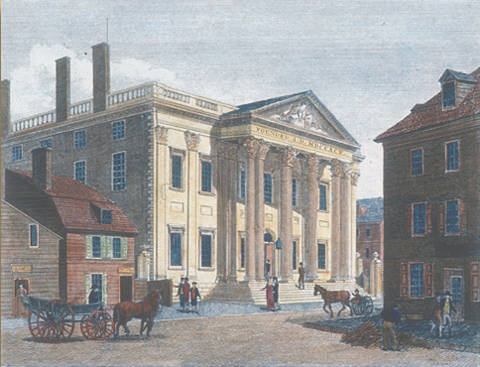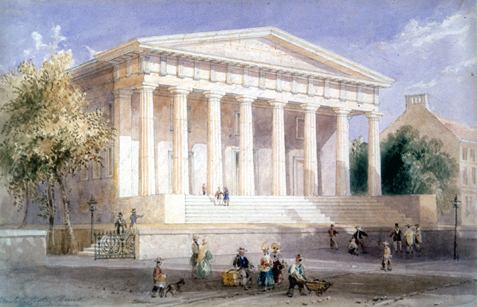First Bank
William Birch
Courtesy Independence Hall National Historical Park, Karie Diethorn, Chief Curator, and with the kind assistance of library technician Andrea Ashby Leraris.[1]The prints in the INHP collection, which originated in various portfolio sets that preceded Birch’s book, The City of Philadelphia, in the State of Pennsylvania North America, as it appeared in … Continue reading
First Bank
First Bank, as it is now known, is the bank that Lewis would have known simply as the Bank of the United States. Its Corinthian capitals and the eagle on its portico were carved only six years before he arrived. To the extent—if any—that Lewis imbibed the political philosophy of Jefferson, he may have viewed the Bank with disfavor as a symbol of a victory of Hamilton over Jefferson in the first clash of their respective interpretations of the Constitution. Hamilton favored strong central government and an expansive interpretation of the constitution, Jefferson an agrarian society of farmers and a “strict” interpretation. In Mr. Jefferson’s Lost Cause[2]Roger Kennedy, Mr. Jefferson’s Lost Cause: Land, Farmers, Slavery, and the Louisiana Purchase (New York: Oxford University Press, 2003), Chapter I, “Choices & Consequences,” pp. … Continue reading, Roger Kennedy argues that Jefferson instead failed to oppose the spread of the plantation system and its slaves, into the territory opened up by the Louisiana Purchase—and lost the cause he had so poetically proclaimed in the Declaration.
Although the constitutionality of a national bank was affirmed during Washington’s administration, Congress allowed its charter to lapse in 1811. The building then was purchased by the prosperous trader and financier Stephen Girard—who in 1807 had become Philadelphia’s first millionaire—and served as a private bank until 1929. The National Park Service obtained the building in 1955, and restored its 18th century exterior in the 1970s.
Second Bank
Second Bank of the United States
Courtesy Independence Hall National Historic Park
Engraving by William Henry Bartlett (ca. 1836)[3]William Henry Bartlett (1809-1854) of London, England, a prolific and widely imitated illustrator, made four visits to the United States between 1836 and 1854. His engravings were published in … Continue reading
The financial crisis experienced in the War of 1812 re-convinced Congress of the need for a national bank. Opened first in Carpenters’ Hall in 1817, the Second National Bank moved into a new Greek Revival building, graced with more conservative Doric columns, in 1824. The power it developed under Nicholas Biddle again met political resistance, and although Congress re-chartered it in 1832, President Andrew Jackson vetoed the bill. Biddle chartered it as a state bank, but it failed in 1841. The Second Bank building became the U.S. Custom House, and continued in that use until 1934.
Notes
| ↑1 | The prints in the INHP collection, which originated in various portfolio sets that preceded Birch’s book, The City of Philadelphia, in the State of Pennsylvania North America, as it appeared in the Year 1800, measure approximately 18 by 14½ inches. |
|---|---|
| ↑2 | Roger Kennedy, Mr. Jefferson’s Lost Cause: Land, Farmers, Slavery, and the Louisiana Purchase (New York: Oxford University Press, 2003), Chapter I, “Choices & Consequences,” pp. 5-16. |
| ↑3 | William Henry Bartlett (1809-1854) of London, England, a prolific and widely imitated illustrator, made four visits to the United States between 1836 and 1854. His engravings were published in American Scenery (c. 1840), History of the United States of North America (c. 1856), and Canadian Scenery Illustrated (1842). |


